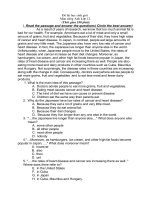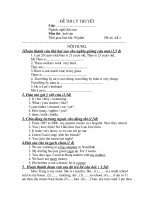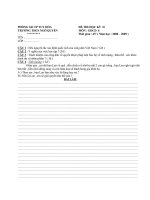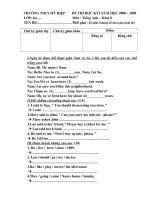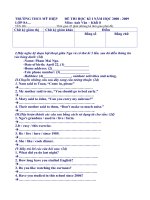ĐỀ THI ANH VĂN NGÀNH THÔNG DỊCH VIÊN ANH-PHÁP 2009 – 2010_3 doc
Bạn đang xem bản rút gọn của tài liệu. Xem và tải ngay bản đầy đủ của tài liệu tại đây (63.66 KB, 10 trang )
TRƯỜNG CD VĂN HÓA NGHỆ THUẬT VÀ DU LỊCH SÀI GÒN
ĐỀ THI ANH VĂN NGÀNH THÔNG DỊCH VIÊN ANH-PHÁP 2009 –
2010
THỜI GIAN: 90 PHÚT
b. could not be forced to attend racially segregated public
schools. c. could not be denied freedom of speech, press,
or religion.
5. On which of the beliefs listed below did Malcolm X disagree with Martin
Luther
King, Jr.?
a. Black people should be assimilated into the larger American
society. b. Black people were not treated fairly by the larger
American society.
c. Black people must gain their freedom now, not in the distant future.
6. Scholars who see the United States as a “salad bowl” emphasize
a. the great extent of racial and ethnic assimilation in the United
States. b. the many differences between racial and ethnic groups
in the US.
c. the rapid growth of the population of the US
7. In American society, there are some members of ethnic groups (such as
some Jews and Hispanics) that are bicultural; they feel that
d. they are fully assimilated into American
society. e. they do not belong at all to
American society.
f. they belong to American society, but at the same time they are
separate
from it
8. Which of these terms should be used to describe the diversity of the U.S?
a. A mosaic b. A salad bowl c. A melting
pot
II/ Answer the questions
1. What is assimilation? Why do minorities have to assimilate?
2. Which group of people in the US establishes the dominant culture
(number 0)?
Number the other 6 groups of people in the order of the degree of their
assimilation into the dominant culture.
WASPs
American Indians
African Americans
Chinese
Northern and Western Europeans
Eastern and Southern Europeans
Hispani
3. Is it important to maintain one’s own ethnic cultural identity and language?
III/ Matching: Melting-pot ? Salad-bowl? Mosaic?
differences
multiculturalis
m
similarities
assimilation
unity of diversity,
E Pluribus Un
IV/ Fill in each blank with one appropriate word
The people of the United States are from a large variety of (1)
groups which represent many races, nationalities, (2)
religions.
Some
of these (3) have assimilated
completely into the main culture while others
(4)_
not.
The more the group differed from the characteristics of the dominant
culture – which was white, (5) speaking, Protestant,
and middle class, the(6)_ the group assimilated,
generally. In the late 1800s and early(7) _ large groups of
immigrants (8) from southern and eastern (9) countries.
Although they were quite (10)
, they were assimilated
into the rapidly growing economy with the help of (11)
bosses. (12)
have had the most difficulty
assimilating
since they
were bought to America as
slaves.
Slavery ended in (13) , but there was illegal (14)__
in the South until the civil rights (15) of the 1960s. Although
much (16) has been made, (17)
_
are still inequalities between (18) races. Now new immigrants
from Asia, the
Caribbean,
and
(19)
America are bringing both challenges and
ne
Discussion
1. Is there discrimination in Vietnam? Is it racial? Social? Sexual?
Regional? Why do you think people discriminate? Why are they
prejudiced?
2. Why do you think people discriminate? Why are they prejudiced?
3. Should minority college students be given special scholarship
simply because minorities - regardless of their ability compared to other
students
Comprehension Check
I/ Fill in the gaps with appropriate information
American people are generally suspicious of a (1) government,
because they think a (2) government would
threaten their (3) .
American revolutionists view government as a necessary (4) .
The principle of (5) government is basic to the
American Constitution and is achieved by the
doctrine of (6) , the system of
(7) , and the system of (8)_ .
T
h
e
S
e
n
ate
T
h
e
H
o
u
se
Nu
m
b
e
r
of
(9)
(10)
Nu
m
b
e
r
of
M
e
m
bers
(11)
deter
m
i
n
ed
by
(12)
Le
n
g
t
h
of
Te
r
m
(13)
(14)
Nu
m
b
e
r
of
Te
r
m
s
no
li
m
it
(15)
_
Age
Req
u
ir
e
m
e
nt
at least
30
at
least
(16)
Citi
z
e
n
s
h
i
p
Req
u
i
re
m
e
n
t
at
least
(17)
_
years
at least
7
years
as
a
Dates
of
Re
g
u
lar
Session
January
3
to
adjour
n
m
ent
January
3
to
adjour
n
m
ent
II/ Answer the questions
1. What is the federal system of government?
2. What is the power of the federal government? What power
belongs to states?
3. Where does the government get the money from?
4. How many people make laws for America?
5. What is a “bi-cameral” legislature?
6. What are the four functions of Congress?
7. Who is the President of the Senate?
8. Who presides over the Senate if the President of the Senate is
absent?
9. Who presides over the House?
10. What party does the Speaker of the House usually belong to?
11. What is the Cabinet?
12. Who decides if the government has done a wrong or bad
action?
13. How are government leaders chosen?
14. What are the checks and balances?
III/ The Check and Balances: Who checks whom? Fill in each
blank with C (Congress), P (President), or S (Supreme Court)
1. can veto bills passed by .
2. can override ‘s vetoes.
3. can declare acts unconstitutional.
4. can declare laws unconstitutional. ( )
5. propose amendments to the constitution. ( )
6.
can
disapprove
the
‘s nominations.
7. can impeach .
8. can send messages to the .
9. can change the number of justices. ( )
10. can nominate judges. ( )
11. can appeal to people. ( )
12. can grant pardons to those who are convicted of federal laws.
( )
IV/ Which party is each sentence about?
1. It is the oldest political party in the United States.
2. It is sometimes called the G.O.P
3. Its first President was Abraham Lincoln.
4. Its first President was Andrew Johnson.
5. It is generally more liberal than the other party.
6. Its members usually prefer to spend tax money for military
purposes rather than for social programs.
7. Its members do not want the government to control the lives
of individuals.
8. The party symbol is the donkey.
V/ Which is NOT true about “special interest group”?
1. They are designed to help protect certain people in America.
2. They are groups of active people who put pressure on the
government to make laws
3. They are appointed by the President to serve the people.
4. They are also called “lobbying groups”.
VI/ Cloze Summary
Americans believe that the (1) role of their government is (2)
protect their individual freedom. (3)
Constitution divides the powers (4) _
the
government
among
the
(5)
branches: the executive, the (6) ,
and the
judicial. This (7) any branch from gaining too much power and
threatening (8)
. Because the ideal of (9) _ free
individual was so (10) _, for many
years
the
(11)
remained
small
and
weak,
leaving
(12)
to pursue
their
individual goals. In the 1930s, there was a severe economic hardship
and the role of (13)
changed. Welfare programs were (14) to help the
needy, (15) the government grew much (16) and
stronger. Also, many (17) groups were established to lobby the
government. Today, almost major groups have a lobby to protect their
(18) and demand for benefits from the government. Traditionally, the
(19)
party
supporters
favored
having
a
big
government
(20)
try to
solve
society’s
problems
and
regulates
business
activities.
The
(21)
party
favored
having a small government with few (22) over business activities.
Although most

